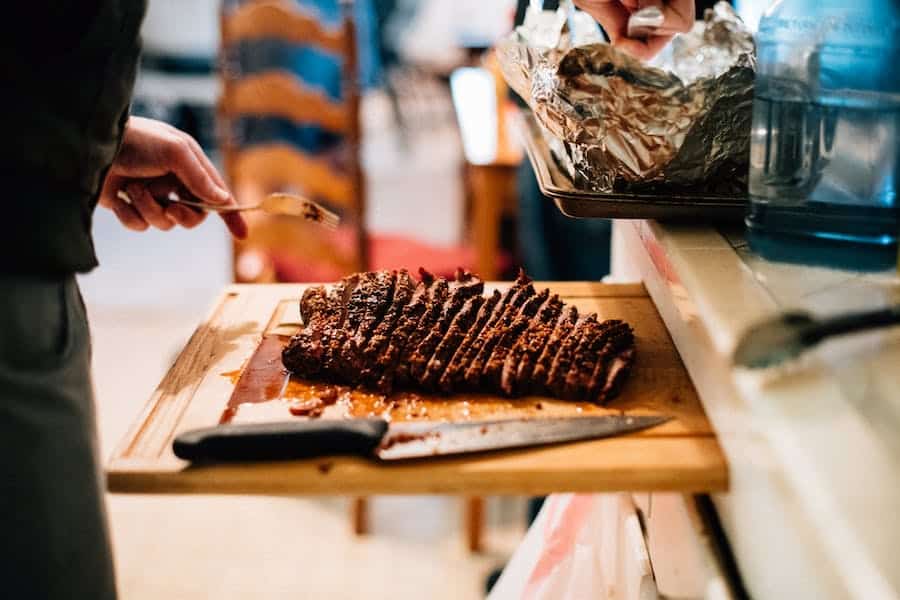When it comes to barbecue and hearty comfort food, few cuts of meat hold a place as esteemed as brisket. Whether you’re savoring tender slices of smoked brisket at a Texas barbecue joint, relishing in a homemade pot roast, or enjoying a mouthwatering pastrami sandwich, this flavorful cut of beef has a special spot in the hearts of food enthusiasts around the world. But have you ever wondered where this delectable cut of meat comes from? The story of brisket’s origins is a fascinating journey that takes us from sprawling cattle ranches to the kitchen tables of homes worldwide. In this exploration, we’ll delve into the history, anatomy, and regional variations of brisket, unlocking the secrets behind one of the most beloved meats in culinary history. So, grab your apron and prepare to embark on a savory adventure as we uncover the origins of brisket.
Where Does Brisket Come From?
Brisket comes from the breast or chest area of cattle. It’s a flavorful cut of meat that’s known for its tenderness when cooked low and slow. Typically, brisket is taken from the lower chest of the animal, specifically between the forelegs. This part of the cow’s body contains a lot of connective tissue, which, when properly cooked, breaks down and results in the juicy, succulent, and melt-in-your-mouth texture that brisket is famous for. It’s a versatile cut used in various cuisines, from barbecue to traditional Jewish dishes like corned beef and pastrami.
Recommended Recipes And Cooking Methods For Brisket
Brisket, with its deep flavor and potential for succulence, truly shines when given the time and care it deserves in the cooking process. Here’s a classic approach to preparing a mouth-watering brisket in the oven, which showcases its tenderness and rich flavor.
Starting With The Prep:
Choose a brisket with good marbling, as the fat interspersed in the meat will ensure juiciness. Begin by preheating your oven to 300°F (150°C). While the oven warms, pat your brisket dry with paper towels. This will help you get a nice search. Season both sides generously with salt and pepper. For an extra layer of flavor, consider adding a rub of paprika, garlic powder, and onion powder.
Searing The Brisket:
In a large ovenproof pot or Dutch oven, heat about two tablespoons of oil over medium-high heat. Once the oil shimmers, place the brisket in the pot. Sear each side for about 3-4 minutes or until a golden-brown crust forms. This searing locks in the juices and starts the Maillard reaction, which deepens the flavor profile of the meat.
Aromatics And Liquid:
After searing, transfer the brisket to a plate temporarily. In the same pot, add a bit more oil if needed, and sauté thinly sliced onions and minced garlic until translucent and fragrant. The onions will pick up the fond, those lovely browned bits at the bottom of the pot, which are packed with flavor. Now, pour in about two cups of beef broth, ensuring to scrape the bottom to release all the flavors. For added depth, a splash of red wine or a dollop of tomato paste can be incorporated. This liquid will not only add flavor but also aid in tenderizing the brisket as it braises.
The Slow Cook:
Return the brisket to the pot, making sure it’s nestled in the liquid. If your brisket has a fat cap, ensure it’s facing up. This allows the fat to go down through the meat while cooking. Cover the pot with its lid or aluminum foil. Transfer the pot to the preheated oven and let it braise for about 3-4 hours. The slow, moist heat will break down the tough connective tissues, turning them into silky gelatin.
The Finish:
Once the brisket is fork-tender, remove it from the oven. Let it rest for about 15 minutes before slicing. Always slice against the grain to ensure maximum tenderness. This oven-braised method transforms the brisket into a dish that’s not just a meal but an experience. The meat becomes incredibly tender, and the surrounding sauce, rich with the flavors of beef, wine, and aromatics, is the perfect accompaniment.
Why Is Brisket So Expensive?
Brisket’s growing popularity, particularly in barbecue cultures, raises a question that many consumers find themselves asking: Why is brisket so expensive? The answer is multifaceted, rooted in supply, demand, production costs, and the unique nature of this beef cut.
- High Demand With Limited Supply: Brisket has gained significant traction, especially in the U.S., due to the booming barbecue culture. The surge in its popularity means that demand often outstrips supply. Each steer or heifer provides only two briskets, which, when compared to other cuts, is relatively limited. This disparity between demand and supply naturally pushes up the price.
- Production And Rearing Costs: Raising cattle is an investment. It involves costs related to feed, labor, land, healthcare, and more. With the trend leaning towards grass-fed, organic, or sustainably-raised beef, the costs further escalate. Brisket, being a prime cut, reflects these increased production costs, especially when it comes from high-quality cattle that are raised under stringent standards.
- Marbling Matters: The brisket’s value is also determined by its marbling, the fat streaks within the muscle. High marbling signifies a better-quality brisket that offers richer flavor and tenderness. Achieving this desirable marbling involves specific cattle breeds and a specialized diet, adding to the overall cost.
- Processing And Aging: The processing of brisket requires skill. Proper trimming, which ensures the right fat-to-meat ratio, is an art. Additionally, some briskets are aged to enhance flavor and tenderness, a process that requires time and proper storage conditions. These factors contribute to the cost.
- Waste Factor: Despite being a large cut, there’s a considerable amount of waste associated with brisket. Between the fat cap, hard fat, and potential connective tissue, a significant portion may be trimmed before cooking. What consumers are paying for isn’t entirely what they’re able to consume, leading to higher prices per actual edible pound.
- Popularity In The Culinary World: Apart from the BBQ culture, brisket has also made its way into gourmet restaurants and culinary experiments, further enhancing its reputation and demand. When a product becomes a star ingredient for chefs, its price often reflects that elevated status.
- Economic Factors: Like all commodities, external economic factors like fuel prices, transportation costs, and even international trade agreements can impact beef prices. Fluctuations in these areas can indirectly affect the cost of brisket.
The Science Behind Brisket’s Texture And Flavor
Brisket, a favorite in barbecues and traditional dishes worldwide, owes its distinctive texture and flavor to a blend of biology, anatomy, and chemistry. To truly appreciate this cut of meat, one must delve into the science that makes brisket so unique and sought after.
- Anatomical Origin: Located in the chest region of the cow, right above the front legs, the brisket is a primal cut. This area supports about 60% of the cow’s weight when it’s moving or standing. Due to this constant weight-bearing, the brisket develops a high collagen content. Collagen, a protein, provides structure and strength to muscles. In the world of cooking, collagen has a two-fold significance. First, it makes the meat tough if not cooked properly. But second, when cooked slowly, collagen breaks down into gelatin, offering the meat its signature tender and juicy texture.
- Marbling And Flavor: A key factor influencing brisket’s flavor is marbling – the white flecks of fat interspersed within the muscle tissue. Marbling plays a pivotal role in determining the quality of beef cuts. These small deposits of intramuscular fat melt during cooking, infusing the meat with flavor, richness, and moisture. In fact, briskets with a higher degree of marbling often command higher prices due to their superior taste and tenderness.
- Chemical Reactions During Cooking: The Maillard reaction, a chemical process between amino acids and reducing sugars, is responsible for the browning of the meat and the formation of complex flavor compounds. As the brisket is cooked, especially when smoked or grilled, this reaction imparts a rich, savory flavor and a delightful crust or “bark” on the meat’s exterior. Moreover, the slow cooking process favored for brisket, such as smoking or braising, allows the tough collagen fibers to break down into gelatin. This not only tenderizes the meat but also gives it a silky, melt-in-the-mouth feel. Concurrently, the fats render out, basting the meat from the inside and keeping it moist.
- Grain Of The Meat: The grain of the meat also influences the texture. Brisket has long muscle fibers, which is why chefs often advise cutting against the grain. By doing so, the fibers are shortened, making each bite more tender and easier to chew.
Final Words
The journey of brisket, from the chest of cattle to our plates, is a testament to the culinary artistry and tradition. Its origins, rich history, and regional variations showcase the versatility and universal appeal of this delectable cut, making it a beloved favorite in diverse cuisines worldwide.
FAQ’s
Is Brisket From A Cow Or Pig?
Brisket comes from a cow, specifically from the lower chest area. It is a flavorful and relatively tough cut of beef that becomes tender and delicious when slow-cooked.
Is Brisket A High-Quality Cut Of Meat?
Brisket is considered a high-quality cut, but it’s important to note that its quality depends on how it’s prepared and cooked. While it contains a lot of connective tissue, which can make it tough if not cooked properly, when slow-cooked or smoked, brisket can be incredibly tender and flavorful. It’s a prized cut in barbecue and culinary traditions around the world.
Is Chuck Or Brisket Better?
Whether chuck or brisket is better depends on your culinary preferences and the dish you’re preparing. Chuck is known for its marbling, making it a good choice for burgers and stews. Brisket, on the other hand, is famous for its deep flavor and tenderness when cooked low and slow, making it ideal for barbecue, pot roasts, and other slow-cooked dishes. The choice between the two ultimately comes down to your cooking method and the flavor and texture you desire for your meal.




















Leave a Reply